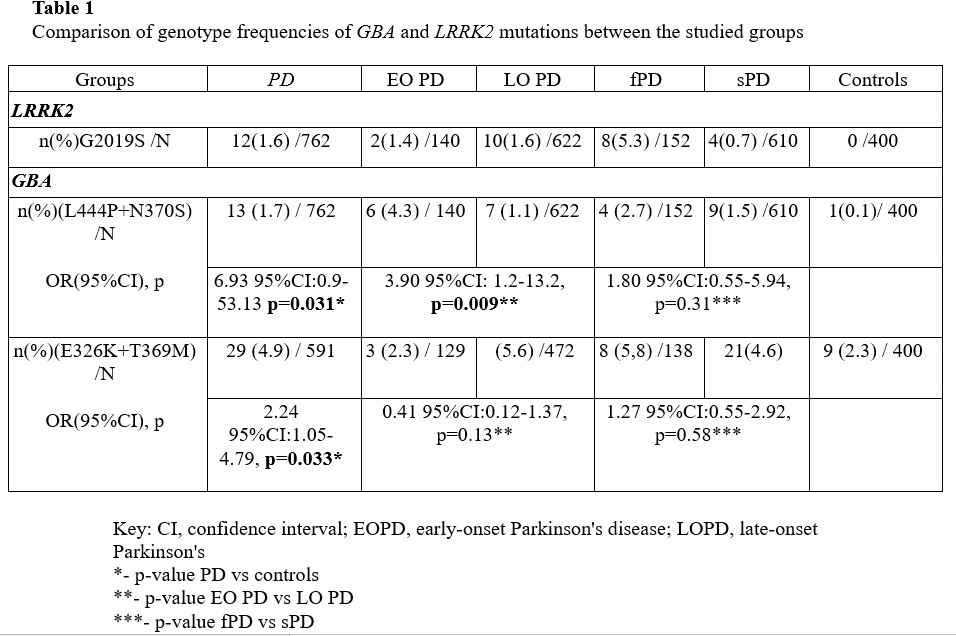Session Information
Date: Monday, October 8, 2018
Session Title: Parkinson's Disease: Genetics
Session Time: 1:15pm-2:45pm
Location: Hall 3FG
Objective: To estimate the frequency of LRRK2 mutation (G2019S) and GBA mutations (N370S, L444P) and polymorphic variants (E326K, T369M) in PD and controls in the Russian population.
Background: To date, a large spectrum of genetic variants has been related to familial and sporadic Parkinson’s disease (PD) in diverse population worldwide. Genetic alterations in GBA and LRRK2 constitute the most common known genetic factors for sporadic PD to date.
Methods: Our series of PD patients is composed of 762 PD patients and 400 controls. PD patients were diagnosed at two neurological clinic centers of St. Petersburg, Russia: First Pavlov State Medical University of St. Petersburg and Institute of Experimental Medicine Clinic. DNA was extracted from the whole blood by the phenol-chloroform method as described elsewhere. Screening of two known GBA mutations (N370S, L444P), as well as two polymorphic variants (E326K, T369M), was performed in both groups of patients and controls using the primers and specific restriction enzymes as previously described. The G2019S LRRK2 mutation was screened using TaqMan probes and verified by direct Sanger sequencing. PD population was divided into two subgroups according to their age at disease onset: early-onset (EO) (under 50 years) and late-onset (LO) (50 years and over). Also, all PD patients were divided into familial PD (fPD) (at least one first-degree relative affected) and sporadic PD (sPD) (patients with no apparent affected relatives).
Results: The frequencies of GBA variants in our PD patients were for: L444P (1.10%), N370S (0.50%), E326K (2.4%) and T369M (2.5%). In controls, the frequencies of L444P, N370S, E326K and T369M GBA were 0.1%, 0%, 1.3% and 1.1%, respectively. Statistical analysis showed that GBA mutations (L444P or N370S) were significantly associated with PD (OR=6.93: 95% CI 0.9-53.13, p=0.031). GBA mutation carriers were shown to have highly increased risk for EO PD with 3.90 (95%CI 1.2-13.2, p=0.009) compared to LO PD. The risk of PD was also twice increased in carriers of GBA polymorphic variants (E326K or T369M) compared to controls (OR=2.24: 95% CI 1.05-4.79, p=0.033) [table1]. The G2019S LRRK2 mutation was as expected more frequent in fPD (5.3%) than in sPD (0.7%) (OR =8.42: 95%CI 2.49-23.24, p<0.0001) while G2019S was not found in controls. G2019S was detected in ten LO PD cases (1.6%) and in two EO PD patients (1.4%) [table1].
Conclusions: LRRK2 and GBA mutations were found to be common risk factors for PD in North-Western region of Russia.
To cite this abstract in AMA style:
K. Senkevich, A. Emelyanov, M. Nikolaev, T. Usenko, A. Bezrukova, I. Miliukhina, A. Kopytova, A. Timofeeva, A. Yakimovsky, S. Pchelina. Frequency of the LRRK2 and GBA mutations in Russian population with Parkinson’s disease [abstract]. Mov Disord. 2018; 33 (suppl 2). https://www.mdsabstracts.org/abstract/frequency-of-the-lrrk2-and-gba-mutations-in-russian-population-with-parkinsons-disease/. Accessed December 7, 2025.« Back to 2018 International Congress
MDS Abstracts - https://www.mdsabstracts.org/abstract/frequency-of-the-lrrk2-and-gba-mutations-in-russian-population-with-parkinsons-disease/

